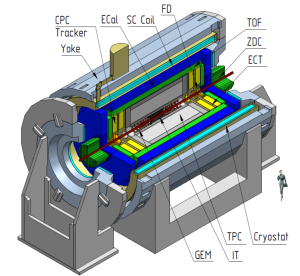
The MPD apparatus has been designed as a 4π spectrometer capable of detecting of charged hadrons, electrons and photons in heavy-ion collisions at high luminosity in the energy range of the NICA collider. To reach this goal, the detector will comprise a precise 3-D tracking system and a high-performance particle identification (PID) system based on the time-of-flight measurements and calorimetry.
The basic design parameters has been determined by physics processes in nuclear collisions at NICA and by several technical constrains guided by a trade-of of efficient tracking and PID against a reasonable material budget. At the design luminosity, the event rate in the MPD interaction region is about 6 kHz; the total charged particle multiplicity exceeds 1000 in the most central Au+Au collisions at √sNN = 11 GeV. As the average transverse momentum of the particles produced in a collision at NICA energies is below 500 MeV/c, the detector design requires a very low material budget. The general layout of the MPD apparatus is shown in Fig. 1. The whole detector setup includes Central Detector (CD) covering ±2 units in pseudorapidity (η).

A general view of the MPD detector with end doors retracted for access to the inner detector components. The detector consist of three major parts: CD-central detector, and (FS-A, FS-B) – two forward spectrometers (optional). The following subsystems are drawn: superconductor solenoid (SC Coil) and magnet yoke, inner detector (IT), straw-tube tracker (ECT), time-projection chamber (TPC), time-of-flight system (TOF), electromagnetic calorimeter (EMC), fast forward detectors (FFD), and zero degree calorimeter (ZDC).
The aim of this Project is to build a first stage of the MPD setup, which consists of the superconducting solenoid, Time-Projection Chamber (TPC), barrel Time-Of-Flight system (TOF), Electromagnetic Calorimeter (ECal), Zero-Degree Calorimeter (ZDC) and Fast Forward Detector (FFD).

